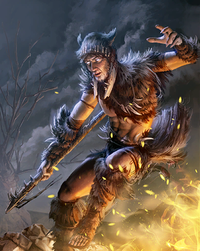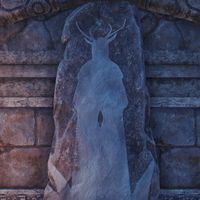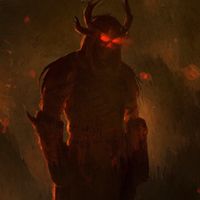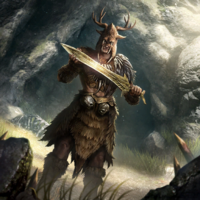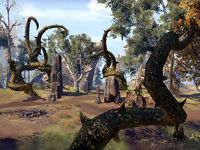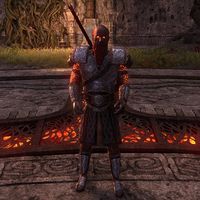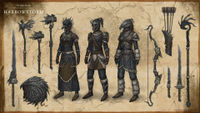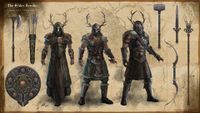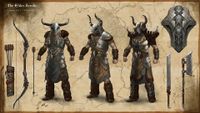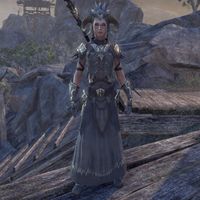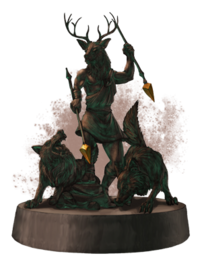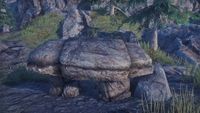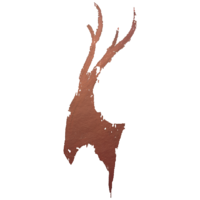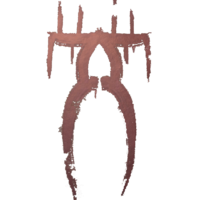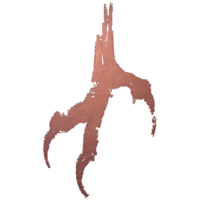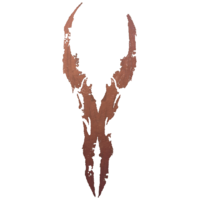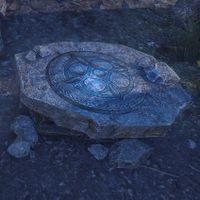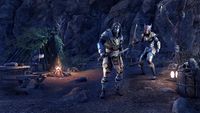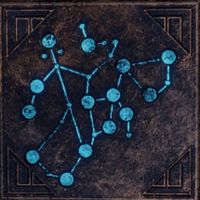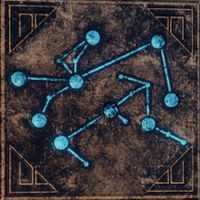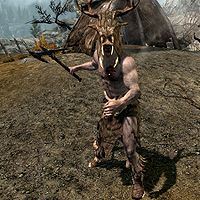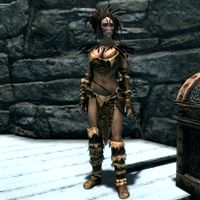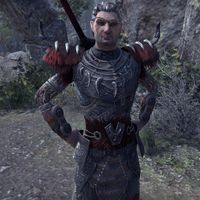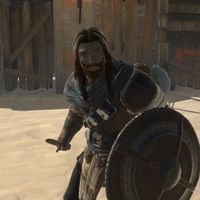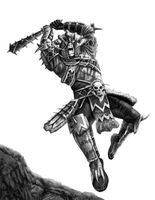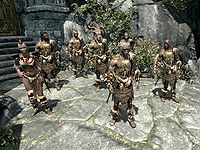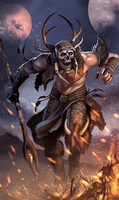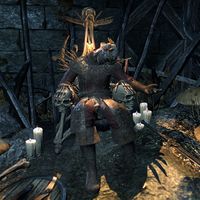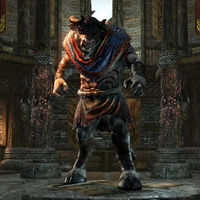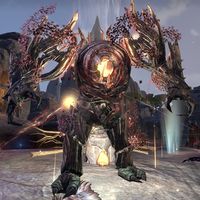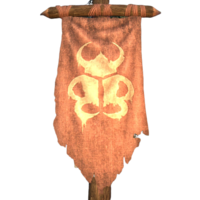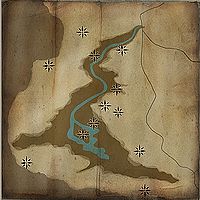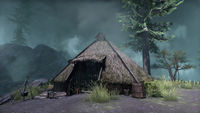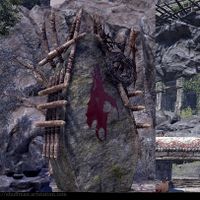Lore:Reachmen
The Reachmen, also known as the Reachfolk,[1] Witchmen of High Rock,[2] and Witchfolk of the Reach,[3] are a race of humans who are native to the Reach in southwestern Skyrim[4][5][6] and the neighboring Western Reach in the east of High Rock, where some Reachfolk families originated from.[7][8][5] They are believed to be closely related to the Bretons. While Reachmen are distinct, they are also mixed with other races that make up Man, Mer, and even Daedra.[9][7] Similarly to the Bretons, Aldmeri blood runs through their veins, which stems from the Direnni Hegemony's occupation of the Western Reach in the early First Era.[7][10]
At least some Reachmen are known to be descended from the Keptu clan of Nedes.[11] Although they are thought to share descent, Bretons do not consider themselves kin to the Reachmen, and the Reachmen do not see themselves as Bretons.[12][13] This sentiment is shared by other races.[14]
Unlike their Breton cousins, who are typically pale and of slight build,[15] Reachfolk are more diverse in appearance, ranging from short and slight framed[16] to taller, broader, and muscular builds, more typical for Nords.[17] Some of the Reachfolk have traits closer to those typical to the inhabitants of the Cyrodiil[18] and a few bear a distinctive red eye color.[19]
Their culture is tribal and diverse; certain clans make little use of advanced technology, while some others employ Dwemer animunculi and advanced alchemy[20]. Many clans utilize hides, bones, and copper to make gear, while others use properly forged weapons and armor[21][22][23] and craft weapons and tools from materials such as dwarven metal,[24] silver,[25][26] and ebony,[27] and even accessories from malachite.[28] Leather and wool are traditionally used as materials for Reachfolk garments.[29] As they are shunned by most of Nord and Breton society, they typically inhabit makeshift fortresses built into caves and ruins throughout the Reach's battle-scarred landscape.[5][7] There are also some similarities in the things worn by the Nedic Keptu and the Reachmen, showing that a cultural exchange might have taken place.[30]
Reachfolk, in a similar way to the Bretons, are often attributed with traits associated with elven cultures, such as secretive, haughty demeanor, and arrogance by their Imperial neighbors.[31]
The Reachmen are also infamous for their advanced hedge magic. Some Reachman mages are known to wield magic with which they can poison or corrupt nature.[32] They are also said to have learned to control beastfolk magic, a wild hedge-wizardry.[10] Some Wyrd Covens, such as the Hagfeather Coven, the Rimerock Wyrd, and the Markarth Sisters, are known to have close relations with the Reachmen and their magic.[33]
Many clans worship Hircine, the most primal of the Daedric Princes. The top of their warrior ranks typically commune with Hircine so that they may ritualistically replace their hearts with poisoned briars, allowing them to become powerful warriors known as Briarhearts. Due to their reverence for Hircine, it is not uncommon to see lycanthropes within the Reachmen's ranks.[31][34] Some Reachmen clans are known to also dedicate ceremonies to Molag Bal, Malacath, Mehrunes Dagon, and Namira.[35][36] Shamans of some Reachfolk clans venerate hagraven matrons, who in turn grant them knowledge of nature magic.[10] Many other Reachfolk clans, however, fear and revile them.[37]
Following the Markarth Incident, Reachmen rebels in Skyrim became known as the Forsworn. Hagravens led splinter groups encamped in various ruins and caves across the Reach.
History[edit]
The Reachmen have long held that they are the true owners of the Reach, and for centuries have only begrudgingly accepted the rule of the Nords and the Empire.[5] Long before the conquests of Mer and Nords in the Karth region, human tribes dwelled within the caves in the Druadach Mountains,[38] where, according to the Vateshrans they fled soon after Lorkh's sacrifice.[39] Those people, the ancestors of the modern Reachfolk, lived there already "when the world was young".[24]
Early Society[edit]
At an unknown point in history between the Merethic Era and 1E 221, in the ancient past, Reachfolk were ruled by the vampires of the Nighthollow Clan, who coveted their blood. The vampiric faction, known to them as "Night Lords", governed them from the depths of Blackreach.[40][41] Eventually, the influence of the vampires waned, and accounts of their terror were reduced to mere bedtime stories.[40]
During the Wild Hunt spawned to kill High King Borgas in 1E 369,[42] the Reachfolk captured one of the monstrosities that were spawned from the event in Skyrim.[43]
Circa 1E 358,[UOL 1][UOL 2] just 3 years after the Direnni Hegemony rose into power in High Rock, the elven overlords had a presence in the Western Reach. The area was later claimed by the First Empire of the Nords. Following the collapse of this Nordic Empire in 1E 420, the Western Reach was retaken by the Direnni,[44] who slaughtered the majority of Nord colonists; as a result, the Nordic ancestry of the Reachmen is comparatively weak.[7][45] Eventually, the Aldmeri overseers were eliminated, but traces of their blood forever remained in the veins of the native Reachmen.[31][7]
The proximity of Reachmen settlements to Orcish villages meant that the Reachmen frequently traded goods and customs with their mountain neighbors, and it is partly from the Orcs that the Reachmen learned to use hedge-magic.[7]
High King Olaf One-Eye later reconquered the Reach for Skyrim at some point during his reign between 1E 420 and 1E 452.[46]
A few years after the disappearance of Dwemer in 1E 700, several clans of Reachmen took refuge in the ruins of Nchuand-Zel during times of seasonal hardship. By 1E 930, the community had developed into a fully-fledged settlement that was active all year round. The Reachmen called it "Mar-Karth", which means "Above the Karth" in the language of the Reach. The strongest chieftain that lived in the town was known as the "Ard", known in the Reach tongue as the "King of the Fort".[47]
During the Siege of Orsinium in 1E 948, Reachmen mercenaries under the command of "the Beast of the Reach" Mercedene of Clan Winterborn fought alongside Bretons and Redguards.[48]
Granite mined from Markarth's quarries by the Reachmen was exported to places such as Evermore, a Breton city founded in 1E 983. Evermore Palace was built out of Markarth granite.[49][10]
The Legend of Red Eagle, an ancient tale from Reach folklore, suggests that during the time of the Alessian Empire, the Reach was ruled by ten kings, and that "though men were free, the people were scattered and warred amongst themselves". The legend also makes reference to the Reachmen's reverence for "the ancient and venerable Hagravens". Despite the quarrels between the Reach kingdoms, they nevertheless expanded and prospered until Empress Hestra and her armies arrived to pacify Reach in 1E 1028; one by one, the kings of the Reach swore fealty or fell to her. The only king who refused to yield was Faolan of Sundered Hills. In order to gain the power needed to defend his homeland, he sacrificed his heart and became the first Briarheart.[50] Faolan and his followers engaged in an extended guerrilla campaign which, while tactically successful, was not enough to stem the seemingly endless waves of Imperial reinforcements. Hestra's generals returned with an even bigger invasion force and laid siege to Red Eagle's stronghold until he himself came forth for battle and killed a thousand soldiers before they brought him down in his final stand in 1E 1030.[51] He became the most famous hero of the Reachfolk.[50]
In 1E 2704, following the defeat of the Akaviri Invaders and the establishment of the Second Empire in 1E 2703, Emperor Reman focused on "the madmen of the Reach" and sliced the Reach in two pieces: High Rock controlled the Western Reach and Skyrim controlled the Eastern Reach. With the growth of the Second Empire, not one decade passed when armies - often sent from Evermore or Solitude - didn't have to suppress the Reachmen.[10]
In 1E 2801 Emperor Kastav ordered the Dragonguard to seize hostages from Markarth and Hroldan to ensure that the jarls met their conscription quotas, which worsened the relations of the Empire with both native Reachfolk and their Nordic occupants. Three years later, in 1E 2804, Reachfolk made arrangements with the representatives of the Dragonguard and provided the order with food when the Emperor cut off supplies as a result of their refusal to help suppress the Winterhold Rebellion.[6]
With the end of the Akaviri Potentate and the start of the Interregnum, the Reachfolk reclaimed their independence and once again took Markarth as their capital, taking advantage of its defenses to stave off attacks from both Bretons and Nords.[47]
The Longhouse Emperors[edit]
The Tagh Droiloch, a secretive coven of witch-men, was founded c. 2E 516. They became a powerful faction and, over time, made themselves the secret masters of the Reach. For years, the Tagh Droiloch preferred to act from behind the scenes and were content to bide their time, allowing the dread of their name and whispers of their displeasure to govern the unruly Reach for them. In 2E 527 an exceptionally strong and cunning Reachfolk chieftain by the name of Durcorach the Black Drake began building a following in the Reach. The Coven decided to ally with the promising warlord. Together, they were able to subdue all the rival clans and effectively unify the Reach. By 2E 528, Durcorach had become a warlord in command of two thousand soldiers, a number that had risen to ten thousand by 2E 529.[52][53]
During the 6th century of the Second Era, the Reachmen seem to have grown particularly powerful, eventually leading to the foundation of a Reachmen dynasty in Cyrodiil known as the Longhouse Emperors.
In 2E 541, the first Longhouse Emperor, Durcorach the Black Drake, invaded High Rock and swiftly captured Bangkorai, Evermore, and Hallin's Stand. Within days, his army was across the Bjoulsae and bearing down upon Wayrest. Durcorach did not have siege engines, so after fifty-seven days of besieging Wayrest, he left part of his army around the town's walls and marched off west into Glenumbra. Taken by surprise, the newly-independent city-state of Camlorn fell and was sacked. The Reachmen were defeated near Daggerfall's city gates after being charged from behind by Emeric's Heavy Dragoons, and Durcorach was killed by Emeric himself.[54]
Nevertheless, Durcorach's dynasty continued to rule in Cyrodiil until the reign of Leovic, Durcorach's grandson. In 2E 573, Leovic was the first Emperor to commission a Guide to Tamriel, labeled 'The Emperor's Guide to Tamriel'.[55] In 2E 577, Leovic was overthrown by his erstwhile supporter Varen Aquilarios, the Duke of Chorrol, after he legalized Daedra worship within the Empire. This marked the end of the dynasty of Longhouse Emperors.
After the Soulburst in 2E 579, several Reach clans allied themselves with the Worm Cult, and remained powerful enough to launch attacks on the Ebonheart Pact and Daggerfall Covenant's territories, even attacking as far afield as the Rift and Glenumbra.[56] Concurrently, one clan of Reachmen known as the Winterborn fought a lengthy war with the Orcs for control of Wrothgar after King Kurog gro-Bagrakh reestablished Orsinium in the region. The war finally ended when the last Winterborn warlord, Urfon Ice-Heart, was slain at Frostbreak Fortress.[56]
During this era, a larger number of Reachfolk than ever ventured out in search of their fortunes.[47] Entire clans could be found within Cyrodiil.[57] While they were eventually expelled from Cyrodiil during the reign of Varen Aquilarios,[58][59][60] by 2E 582, some could still be encountered in the former Imperial territories, including Blackwood.[61][62][63] These Reachfolk came to be known as Imperialized Reachfolk.[64] However, many of them eventually made their way back to the Reach.[65][66][67] Reachfolk travelled abroad to the lands of Aldmeri Dominion, Daggerfall Covenant, and Ebonheart Pact,[68] and could also be encountered in foreign lands,[69] affiliating themselves with various foreign factions,[70][71][72] and some even delving into the realms of Oblivion, such as Fargrave,[73][74][75] the Deadlands,[76] and Apocrypha.[77][78][79]
Battle of Old Hrol'dan[edit]
In the 9th century of the Second Era, some Reachmen allied with the Second Aldmeri Dominion. As a people, the Reachmen remained largely independent – although they frequently clashed with the Nords to the east – until the arrival of Tiber Septim at the end of the Second Era.[80] In 2E 852, King Cuhlecain's general successfully broke through the Reachmen's lines, forcing them to fortify themselves at Old Hrol'dan. The next day he approached the gates of the besieged city, protected by the winds created by a storm following his trail. Reports say that the ancient Nord art of thu'um was used to shout down the walls of Old Hrol'dan, after which the army of Colovian troops and Nord berserkers took the city with relative ease.[80] Markarth and the lands of the Reach were soon occupied by the Nords,[81] while Imperial propaganda branded the Reachmen as rebellious and lawless mongrels.[7]
The Forsworn Uprising[edit]
In 4E 174, during the Great War, when the Empire did not have the resources available to maintain the outer provinces, a group of Reachmen led by Madanach (who would become their king) commenced what would later be known as the "Forsworn Uprising", gaining control of the Reach and creating an independent kingdom.[82] According to Arrianus Arius, they administered the kingdom relatively peacefully, with only a few of the harshest Nord landowners put to death.[82] After two years, their experiment with independence seemed largely successful, and the leaders of the Reachmen were beginning the process of seeking recognition from the Empire.[82] However, in 4E 176, desperate to retake the Reach and with no Imperial Legions available due to the Great War, the previously deposed Jarl Hrolfdir enlisted the aid of a Nord militia led by Ulfric Stormcloak to retake the Reach by promising them free worship of Talos. In that year, the Nord militia successfully drove the Reachmen from the city of Markarth and reclaimed the Reach, executing officials who worked for the Forsworn and those citizens who did not join the Ulfric's forces, including Nords, elderly, and children deemed old enough to be able to fight, as well as torturing natives to give up names of the rebels who fled into the wilds.[82][83] The survivors of the uprising fled into the wilds of the Reach and became known as the Forsworn.
Driven from Markarth, the Forsworn spread across the Reach, fortifying any defensible spot they could find. In the wilds, the Forsworn function as a terrorist organization; they are composed of a series of cells, usually led by hagraven "matrons" or Briarheart warriors, with their main tactics being caravan raids and attacks on outlying settlements.[84] The ongoing dispute caused consternation for those Reachmen who were not allied with the Forsworn. Native landowners were frequently under duress by both the Nords and the Forsworn, each party thinking the individual was working for the other.[85] Many Reachmen also lamented that so many of their friends and loved ones were fighting and dying in service of a long lost cause.[86]
Society[edit]
The Reachfolk live in scores of fractured clans, each with their own traditions and character. There is no uniform tradition among the clans, though many of them share deities and practices. Some clans are nomadic, while others settle in one place and build villages. Some people in a clan may be related to each other, and others adopt clan names to mark their allegiance. New clans are synthesized all the time as like-minded individuals come together. Sometimes they seek to settle new land or follow herds of prey, and other form to plunder and raid neighboring lands. In this way, the clans are fluid, breaking up and reforming throughout history. Many clans try to live in relative peace, though some, such as the Boneshaper Clan, are overtly hostile towards outsiders. Most clans are minor, consisting of small villages, bands of nomads, or groups of marauders that hole up in caves or old forts. However, there are larger, more prominent clans.[87] Some clans of the Reachfolk build hunting lodges decorated with Alrabeg's imagery,[88] and ritual huts.[89][90] Reachfolk have a huge variety of body markings that are based on the clan they belong to.[91]
Each clan is led by a chief, who may be called a chieftain, speaker, elder, or king depending on the clan and who the leader is. Most Reachfolk believe that chiefs who call themselves "kings" are just putting on airs. The clans are many and don't agree on everything, thus it is impossible to unify the clans beneath a single power. Any clan-chief can call himself a king. In fact, there have been points in history where several chiefs have claimed the title of "king" for themselves simultaneously. The Reachfolk have a saying: "anyone can be a king in the Reach, but no one is King of the Reach". Durcorach the Black Drake never took up the title of king for this reason. The Reachfolk viewed the Longhouse Emperors as war-leaders they followed of their own volition as opposed to a uniting force that ruled over the Reach as a whole. From the Reachfolks' perspective, kneeling to a king, no matter what race they are or if they've claimed the throne of Cyrodiil, is something that weaker peoples do.[87]
Many clans live upon the shores of the Karth River, a place as harsh and uncaring as much of the rest of the Reach. Its fierce rapids veer around sharp stones, and it rides over steep cliffs that create powerful torrents. The people who rely upon the river live only if the river allows it, and its inhabitants respect it for its dangers and what it provides. The Reachfolk bathe in it, wash their clothes in it, drink from it, and cook their food with it. They regard the Karth river with respect, and at the very least, consideration. The folk who live upon the river's banks see what the river takes from them as a small price to pay for what it provides. They take from the river, and it extracts a price in return. The people of the Karth River don't blame it when it sweeps away structures and people; they accept that life near the river has its hardships, and they endure.[92]
Culture[edit]
—Gorrof
The Reachfolk have rich oral traditions and don't commit their stories to paper as scholars from most other provinces do.[93] Many from clans who live in the wilderness are illiterate and do not care to learn.[94] Some Reachfolk are even opposed to the idea of learning to read and write.[92] Some Reachfolk who served the Longhouse Emperors in Cyrodiil during the Second Era encouraged their children to learn their letters. Following the fall of the Longhouse Dynasty, there was not much call for reading and writing in the Karth Valley, barring major settlements like Markarth, where such skills were more widespread.[24][67]
Reachfolk occasionally adorn their weapons with Daedric inscriptions.[95] They also utilize glyphs.[96] Verses of the Red Eagle's Song were carved into stone pillars in the sacred cave in Red Eagle Redoubt.[97] Several major clans of the Reach such as Winterborn,[98] Dreadhorn,[11] Icereach,[99] and Doomfang [20] shown high proficiency in writing. The Forsworn also were known to read and write.[100][101]
The Reachfolk value hard work and struggle. They hold people who regularly work with their hands or perform manual labor in high regard, and respect them more outwardly than some other cultures do.[102] The Reachfolk understand that hardship is inevitable, but instead of bemoaning their sorrows, they embrace the pain as wisdom.[103]
Reachfolk do not condone stealing from other Reachmen, and theft is a very rare occurrence unless the clans are feuding.[104] Theft is considered a serious offense among the Reachfolk, whether they dwell in the city of Markarth or in the rocky hills of the Karth Valley.[18][105] While the customs of the clans that live in the mountains are varied, the Reachfolk of Markarth punish theft severely. One of the customary punishments for such a crime is hand amputation.[105]
Reachfolk are known to dance often and are perceived as great dancers by the outsiders.[106] Their dances are often related to ancient rituals, complicated in nature and involve numerous clan members.[107][108] Some clans value dancing skills very high.[109]
Reachfolk deal in bargains, respect strength, and skill, and believe in rewarding favors.[41] Offering favor for a favor is considered one of the more common ways of how business works in the Reach,[110][111] and is one of the old and respected customs.[112]
Rites of Passage[edit]
When children from the Spiritblood Clan grow strong enough, they perform the Vateshran's Rites to ascend to adulthood. The rites separate the strong from those too weak to live in the Reach.[113] If they survive the challenge, the child emerges a full warrior, and carries all the privileges and responsibilities that adulthood in the clan offers.[114] They train their entire lives for that day, and begin their trial knowing that the Rites could kill them.[115] To complete the Rites, a child must traverse Vateshran Hollows, a cavern filled with summoned Daedra.
Reach-magic[edit]
Reachmen are often referred to as the Witchmen of High Rock, a name given to them due to their use of dark "Reach-magic". It is believed that they learned much of this magic through trading with the Orsimer, their neighbors who also occupy the Wrothgarian Mountains.[2] Another source for their magic comes from hagravens, which involves "ecstatic ceremonial heres[ies]", such as sacrifices, to acquire dark nature magic.[31] Hircine is believed to be the source of where Reach-magic is drawn from.[116] The dark magic has been outlawed within the Mages Guild, though that has not stopped the art from being widely studied.[2] The ban is for good reason, however, as one of the most notable conjurations can be devastating. Indeed, by using Reach-magic on the remains of ritual sacrifices,[117] one can create the bloodthirtsy,[118] thorned, and giant twisting roots known as Bloodthorn/Bloodroot vines,[119][120] which can be used to corrupt the land,[121] or shaped into "rough mockeries of life".[117] An example can be found within the Huntsman's Bloodroot Forge. The Dreadhorn Clan's hagraven shaped the vines that thrived within the Forge into Nirnblooded creatures,[122] primal creatures comparable to those of the Bosmer's Wild Hunt, but infused with the power of Nirncrux.[123] Transformed, these vines still hunger for blood.[124]
Molag Bal can grant a similar power to gravesingers. The name "gravesinger" is given to some Reachman necromancers who broker deals with Bal[121] in exchange for the power to command the loathsome dead.[31] Indeed, gravesingers can command corpses by planting the seeds of foul vines in their victims' bodies. Molag Bal's "gifts" may leave a gravesinger's body in a state of decay.[125]
Mysticism was common magical art among the mystic shamans during the Second Era.[126] Reachfolk consider themselves to be among the finest healers in the world.[127]
Transformations[edit]
Many of the transformations Reachmen undergo are associated with Hircine:
The briarheart ritual is reflective of the Reachfolk's need to become better to overcome hardships. It involves communing with Hircine to ritualistically replace the heart of a skilled Reachfolk warrior with poisoned briars.[31] This ritual is representative of Lorkh's immortal sacrifice,[128] which is reflected by the sacrifice of ones' own life; the end result is a warrior being resurrected[129] as a living weapon with great strength and endurance known as a Briarheart.[37] They will bear the suffering of constant pain[130] to use their transformation's benefit to protect their clan.[37] In a similar vein to Briarhearts, lycanthropy is viewed by most Reachfolk as self-sacrifice, for it is seen as more of a useful condition rather than a gift, one which one suffers with so they can better benefit their clan.[131] Some Reach Clans however have proven to be zealous about the gift, as conflicts between them and the Viridian Wyrd coven have been reported due to them offering a cure to Lycanthropy.[33][132]
Another transformation is associated with one of Hircine's creation, the Bloodroot Forge, which is capable of turning people into Blood-Forged. They are comparable to Briarhearts, but their creation instead involves a nirncrux heartstone being used in place of a briar heart,[133] resulting in a being that is an amalgamation of blood, nirncrux, and iron.[134]
There have also been instances among the Winterborn of their warriors transforming themselves into briarheart tree lurchers through incredibly powerful Hagraven rituals of "fire, vines, and blood".[135][136]
Food[edit]
- Main Article: Reachman Cuisine
Alcohol is a commodity that the more open-minded clans of the Reach are willing to trade for. Much of the Reach is unsuitable for the barley fields, vineyards, apiaries with which other cultures brew their drinks. Clans who don't have much contact with the outside world make do with what they have. Reach-made drinks are found primarily in the form of hard ciders. The flavor profile of Reach cider is varied. Dark, musty brews tend to be sweet. There are also clear, sour brews that have been described by visiting Nords as an acquired taste. The flavor depends on the variety of apple used and the time of year they're pressed. Apple orchards are uncommon in the Reach, but many apples grow in the region's forests and river valleys. Each clan that lives where the fruit grows has their own preferred method for brewing cider.[137] Reachfolk cider is praised for its quality by some whilst others consider certain varieties to be a sour acquired taste.[91][137]
Language[edit]
- Main Article: Reach-tongue
Reach-tongue is the language of the Reachfolk.[138] As an isolated culture, they've developed their own dialect over time.[UOL 3]
Fashion[edit]
Clothes and Armor[edit]
Leather and wool are traditionally used as materials for Reachfolk garments.[29] Most of a Reachfolk clothing is purely functional, although the bright colors are favored.[139] Imagery of knotwork resonates with Reachfolk.[140]
Sturdy leather belts are intended to last for many years. They are usually tooled with stylized images of beasts the wearer holds in high esteem. Bear, elk, wolf, and raven images are most common.[141][142]
Reachfolk shoes are sturdy and usually made from fleece-lined elk hide, secured with tough rawhide thongs. Occasionally they feature studded soles for traction in snow, ice, and steep hillsides.[141] Reachfolk of the Icereach prefer shoes with a three-pointed shape.[143]
Reachmen prefer open-fingered hand wrappings to full gloves. During seasons of cold weather, they often wear mittens made of hide or fleece. Occasionally studs made of carved bone are added to the gloves.[141] Reachfolk of Icereach prefer full gloves and occasionally adorn their fingertips with sharp metal akin to claws of Hagravens.[143]
Reachfolk pants are often made from elk and deer skin[18] and bear intricate ornaments of animals such as wolves, ravens, elk or bears.[141] Significant number of Reachfolk clans opt for wearing kilts instead.[142][143][21]
Shoulderpieces of Reachfolk usually are purely decorative in stark contrast to their general utilitarian approach to garments. Countless different and unique patterns and decorations consisting of rib-bones, rare furs, small animal skulls, or wooden ailettes carved into fierce faces are observed among Reachfolk.[141] Icereach coven utilize hay and twigs to add their shoulderpieces more distinctive appearance and reinforce them with tough bark and bones.[143]
Reachfolk headgear is very diverse. While most Reachfolk helmets are made from leather, they are also occasionally utilizing skulls of various animals. Antlers are a common headgear element - they are worn in order to honor Hircine.[141] Some headgear also contain wings of the birds [144] as well as parts of sabre cat's heads.[145] It is also not uncommon among the Reachfolk to wear decorative horns on their foreheads.[146]
Reachfolk of Icereach wear wicker masks resembling faces with unsettling expressions and exaggerated features. Some masks sport horns and dark, soot-colored feathers, some possess hooked beaks.[143] Bull-Heart Warriors of the Reach wear sallets made of bull's skulls during the Horned Triumph ritual. [147] Stag-Hearts don similar sallets, but made of stag's skull instead. [148] Crow-Heart Warriors helmets typically incorporate imagery of skulls of great predatory birds.[149] due to common belief among the Reachfolk that mage can draw power from trophies of the hunt. Reach mages often wear skulls of the animals.[150] In honor of legendary witch Naenra Waerr, Reach witches who pass the final test of wisdom and power set to them by a clan elder gain the privilege to craft ceremonial mask with ram horns imagery.[151]
Dreadhorn clan use mammoth[21] and bull skin as well as minotaur's hair as material for their attire. They adorn their clothing with imagery of bull and curling vines.[142] Reachfolk occasionally incorporate Dwemer designs into their attire as well as materials such as Dwemer metal and silver. [25] Timbercrow Clan is known for their light and simple garments in form of traditional loincloths.[152] Women of the Stonetalon Clan usually are covered in heavy cloaks made of bird feathers.[117]
Accessories[edit]
Reachfolk hairpins are occasionally crafted from malachite and adorned with animal motifs. [28] Small beads carved from blue stone are used in Reach courtship rituals.[153] Reachfolk of high status often wear dyed feathers with intricate carvings on their vanes.[154] Reachfolk of Icereach adorn their clothes with talons and small skulls of birds.[143] Champions of the Kairian Coven wear wicker crowns.[155]
Reachfolk are skilled in the area of body marking and tattoos. They have a huge variety of body markings that are based on the clan they belong to.[91] Reachfolk body markings are generally seen as strangely beautiful, although primal and not subtle by the members of other races.[156] Dreadhorn clan uses bull imagery in their tattoos.[157][158] Death Crow tattoo, which uses the imagery of Daedric Prince Nocturnal is one of the favorite of Reach clans.[159] Many of the Reach clans along the Karth River worship Hircine, and take wolves as their totems. Certain tattoos evoke that heritage.[160]
Reach warriors sometimes use plant-based stain to dye their teeth crimson in order to terrify their foes.[161] Reachmen from the Dark Witness clan typically use deep blue war paint.[162]
Reachfolk are known to utilize lye in haircare.[163] Beards are occasionally waxed with the grease of mammoths, and combed with the use of combs made of bones.[164]
Religion[edit]
Every clan of the Reach has slightly varied approach to the religion. They worship both ancestors, various lesser spirits that are unique to each clan as well as more powerful entities called Great Spirits.[131] Certain foxes and elks held sacred status, and their leathers were reserved for special occasions.[165][166] Some clans revered the nature spirits associated with animals or the nearby springs.[131] It was customary to thank to nature spirits before felling trees. Subsequently, the Reachfolk often would plant new saplings in the vacant space left by the fallen tree.[167] The Reachfolk do not worship the Daedra in the sense that people in other parts of Tamriel worship the Divines; rather, the beings they call spirits play an important role in their daily lives. They have what can be described as a give and take relationship with the Daedra, forming agreements for assistance with everyday tasks and challenges.[107] Religion of certain clans of the Reach does not involve Daedra at all. Only a part of Markarth's city clans engaged in Daedra worship,[168][169] and within this subset, certain Daedra, such as Malacath were even less popular.[170] Certain aspects of the Reach theology share similarities with the religious practices of the Druids.[171][172] As of 4E 201, they referred to the spirits as the Old Gods.[173]
Hircine (the Hunt-Father) Hircine is one of the most prominent spirits venerated by the Reachfolk, and plays a role in their creation myth.[128][174] He teaches the Reachmen to live "in the now",[24] and to be cunning and strong so they may survive in the Reach.[131] Followers of Hircine in Markarth worshipped him in the Shrine of the Hunt-Father.[175]
Namira (The Spirit Queen / the Goddess of Death) Namira is the spirit of darkness and endings, but also a spirit of rebirth. She is considered to be a powerful force in the natural world. [107]
Malacath (The Lord of Ash and Bone) Malacath's true chosen people is the Reachfolk, according to some Reachmen tribes, and he created Orcs, Ogres, and Trolls to test them.[8] He is not a popular spirit among the Reachfolk of Markarth.[170]
Nocturnal (Mistress of Shadows) She is ever watchful, watching since the beginning.[176] She is the spirit of the night. The Reachfolk give her offerings in the hope that she'll send her crows to watch over them.[177]
Molag Bal (Father of Torment) The spirit of torment and trouble, he teaches Reachmen to endure their struggles.[177] The Reachfolk see Molag Bal as one who enjoys playing tricks and setting traps to ensnare or test mortals.[103]
Mehrunes Dagon (Lord of Destruction / Lord of Ambition) The spirit of ambition and destruction.[103]
Peryite (Master of Tasks / Lord of Order) is a revered spirit in the Reachmen pantheon that shares many characteristics with Akatosh, in pivotal ways such as being attributed to "time, rigid natural order, (and) draconic imagery". This has lead to scholars concluding that there was a cultural diffusion between the early ancestors of Men and Mer in the Northwestern parts of Tamriel. To describe Peryite as a necessary evil would be a misnomer, for while the Reachfolk see him as necessary, they see the good in him maintaining a balance as a force of nature. While a Reachmen may be claimed by a blight or plague, they will come out of these natural tragedies healthier. This keeps the dangers of overpopulation in check, and allows a new generation of Reachfolk to build immunities to what Peryite throws at them.[178]
Although he is not a Daedric Prince, Reachmen acknowledge Lorkh as the Spirit of Man and associate him with story of creation. Despite the fact that his name is never spoken in prayers, Lorkh is nevertheless revered by all Reachfolk clans.[24] As of the Fourth Era, some Reachfolk cults of Mephala were active.[179]
Occasional evidence suggests that Aedra may also play a role in Reachfolk religion:
- In the Second Era, The Dreadhorn Clan utilized shamanistic Kyne-magic during their assault of Falkreath Hold.[UOL 4] When the Forsworn controlled Fort Sungard, a shrine to Kynareth could be found inside the Fort.[180]
- Circa 2E 582, the Eagleseer and Six-Ford clans were to hold a handfasting upon an altar of Mara at Hroldan Ring to unite the two clans, but it is unknown if they actually worshiped Mara herself.[181]. One of the direwolves kept in the Shrine of the Hunt-Father's grounds was named after Mara.[182] As of 4E 201 several Reachfolk accept marriage under Mara.[183] Spirits of Briarhearts, whose original hearts were defiled are unable to pass to the afterlife,[184][185] unless the original heart of the deceased Briarheart is purified at the shrine of Mara and properly buried.[186]
- As of 4E 201, the Temple of Dibella at Markarth was held in high esteem by some Reachmen,[187] and the daughter of a Reachfolk couple was chosen to become Dibella's Sybil.[180]:332[188] There was also a Shrine of Dibella present at Broken Tower Redoubt, which had been occupied by the Forsworn. It is unclear if the shrine was being worshiped at or if it had been desecrated.
- As of 4E 201 some Reachfolk follow Eight Divines.[180]:332[189] There was no evidence of Talos worship present in their culture, however.[190][173][191]
- Magnus is acknowledged by some Reachfolk.[192]
- During the Interregnum, the city of Markarth was decorated with imagery associated with Zenithar during special celebrations dedicated to the god.[193] In the Fourth Era a shrine of Zenithar was found close to the Four Skull Lookout.[194][195]
Reachfolk practice Ancestor Worship and have a class of story-tellers called vateshran. Their job, among other things, is to ritualistically commemorate the dead ancestors of the clan through song.[196] Reachfolk honor their ancestors by living the life the way they did and believe that their ancestors observe them from the sky above and await reunion during which the stories of the battles their descendants fought will be exchanged.[24] Some of the clans ritually sacrifice animals as a form of offering to the ghosts of venerated ancestors and ancient heroes.[131] Venerated ancestors in turn are believed to communicate[197] and occasionally share wisdom with their descendants.[103] Although Reachfolk venerate numerous ancestors the most known ones are:
Aydolan was an ancient Reachfolk storyteller and historian who created the Vateshran's Rites performed in the ancient caves of the Vateshran Hollows. Following his death he remained on the Nirn as ancestral spirit for over one thousand years to oversee the trials and guide the generations of Spiritblood.[103]
Faolan was ancient Reachfolk king and most known legendary hero among their kin. By the Fourth Era, a radical faction of the Reachfolk, the Forsworn, drew several parallels to the struggles of Red Eagle and his oppression under an occupying force. As such, many of them extolled his teachings and practices, looked up to him as their savior and sought his blessings. They planned to resurrect him through the ancient ritual so he can reclaim the freedom of his people and rule the Reach forevermore.[198][199]
Naenra Waerr was an ancient witch responsible for the creation of the Umbra Sword.[200] Reachfolk witches who pass the final test of wisdom and power honor her by crafting masks akin to one they believe she used to wear when crafting Umbra.[201]
Origin[edit]
The Reachfolk believe in the existence of only two worlds; the worlds of flesh and spirit.[174] However, the world of flesh didn't always exist. Legends speak of Lorkh having an epiphany when he visited the darkness; that what is perceived as nothingness is ripe for possibility, for he saw the potential for there being more than just the realm of spirit.[202] And so, Lorkh approached Namira, the queen of the spirit world,[174] seeking a place within her infinite void that he could create a realm for wayward spirits. But it was not without a cost. Lorkh sacrificed himself to create a harsh realm, one that is unforgiving and intended to teach through suffering.[128] As a result, the Reachfolk look to less conventional gods for worship, who serve as lessons rather than beliefs.[174]
What ensured is shrouded in the allegory "And unto the mountains they fled, for the world grew dark with shadows which sprung from the heart of Lorkh, who though greatly sundered still believed in the light of Man".[39] After the fall of Lorkh, Hircine became the Lord of the Arena,[203] and took the mantle of Lorkh's creation, becoming the sovereign of the realm of flesh.[174] He became the most prominent deity to the Reachfolk, as he took an active leadership role, and shaped them to become survivors in the harshness of Nirn.[131]
Celebrations[edit]
Reachmen celebrate the end of the old year and the beginning of the new year.[204] They believe that with the coming of the New Life Festival, two of Hircine's aspects come to conflict with each other. New Life marks the winter solstice, when the days begin to lengthen due to the return of the sun. Storihbeg the Man-Beast thus pursues the sun in an attempt to eat it, an effort to keep the nights longer. To prevent this, Reachmen summon Hrokkibeg the Mighty Bear to keep Storihbeg constrained and protect Magnus.[192]
Namira's Dance is a ceremony performed by Reachfolk of the Boldclaw Clan. All clansmen unite together to pay respects to Namira, goddess of death and rebirth. Some are dressed in dark colors, with black facial paint, others arrive naked, to symbolize the beginning of life. Those who are able dance together in unison. During the celebrations, human blood is spilled for Namira, yet no violence is involved. Members of the clan do various things with the collected blood. Some sweep the blood under their eyes, others press bloody handprints to the ground. Despite the presence of blood, these celebrations are joyous in nature.[107]
Death Beliefs[edit]
- Main Article: Reachman Death Beliefs
The Reachfolk believe the world is divided in two realms: the world of flesh is the mortal plane, which they believe is governed by Hircine. The world of spirit governed by Namira. Hircine and Namira's roles complement each other. While Reachfolk dwell in the world of the living, Hircine is a guide that helps them navigate Nirn's hardships.[24] Upon death, Namira acts as a psychopomp for Reachman souls that gives and takes lives, until their spirits are enlightened. Thus, Namira is seen as the avatar of primal dualisms, such as beginnings and ends, which stem from her world of spirit.[174]
Sky Tales[edit]
Sky Tales are Reachfolk term for the constellations.[65] Some Reachfolk Witches can read the stars and see the future and hidden truths in their light.[65]
Three Guardian Constellations are known as Reach Guardians[65] and Guardians in the Sky.[25] The Witch in the Stars, the Hunter, and the Headsman work together to protect the Lesser Stars from the malevolent Sky Tale known as the Snake in the Stars. Around 2E 582 the Wayward Guardians led by Arana recognized the power of the Reach Guardians and invoked their names for the protection against the Gray Host.[25]
The Witch in the Stars The Mage Constellation is known as the Witch in the Stars, which is often shortened to the Witch. She is one of the three Reach Guardians and shines her light on covens that protect the Reach from outsiders and others who mean to do Reachfolk harm. Her good eye sees through everything, be it rock, water or flesh to find the hard truths. Whenever she speaks, she never lies.[65]
The Hunter The Thief Constellation is known as the Hunter. She is one of the three Reach Guardians and is believed to be the wiliest of the sky tales. She is as clever as an old fox and as swift as a young one. One of her duties is to observe the Snake in the Stars movements. She always finds it no matter where it slithers. Teachings of the Hunter are known to the Reachfolk. She taught them how to keep their feet quiet and their kills as silent as the night.[65]
The Headsman The Warrior Constellation is known as the Headsman. He is one of the three Reach Guardians and is typically depicted carrying the axe. The Headsman stands for swift ends and payment in kind. He delivers justice and punishment in equal measure.[65]
The Snake in the Stars The Serpent Constellation is known as the Snake in the Stars, which is often shortened to the Snake. It is also occasionally referred to as the Enemy and the Corrupter. The Serpent is the enemy of the Reach Guardians. Reachfolk believe that if permitted, Snake would consume all the Lesser Stars without hesitation.[65]
In the year 2E 582, Arana and the Witch-Rebels agreed to form a proper alliance with House Ravenwatch and the Vestige, but only once the ritual honoring Hircine was performed to finalize the binding pact between parties. The ritual was successful and revealed the sigil of the Snake in the Stars. Initially, Arana interpreted it as the substitute for their prey but soon realized that the clue sent by the Daedric Prince referred to the Sky Tales.[65] The Dwemer plaques led to Bthar-Zel, where they hoped to find materials to arm themselves against the invasion of the Gray Host.[205] One of the Reachfolk glyphs depict the snake.[206] Its connection to the Snake in the Stars is unknown.
Lesser Stars Other Constellations, widely known as the charges are known as the Lesser Stars. Reach Guardians protect them from being devoured by the Snake in the Stars.[65]
Known Reachfolk Groups[edit]
The Reachfolk organize themselves into a panoply of clans and independent factions.
- Main Article: Reachman Clans
Gallery[edit]
Appearances[edit]
Miscellaneous[edit]
-
A map of Forsworn camps in The Reach in 4E 201 (Skyrim)
Notes[edit]
- The term "Witchman" is also used to refer to Reachman Shamans specifically.[10] Male witches are referred to as "witch-men".[52]
See Also[edit]
- Reachman Names
- For a list of notable Reachmen, see here.
- For game-specific information, see the Skyrim, ESO, and Legends articles.
Books[edit]
- Politics and History
- The Battle of Karthspire Lea by Vateshran Barth — An old story about an undecided battle of blood
- The Bear of Markarth by Arrianus Arius, Imperial Scholar — An account of Ulfric Stormcloak's short-lived independent reign over the Reach
- The City of Stone by Amanda Alleia — A mercenary's guide to Markarth
- Politics of the Reach by Consul Cardea, the Ard's Administrator, 2E 578 — An overview of politics between clans in the Reach
- The Legend of Red Eagle by Tredayn Dren — An ancient tale about the invasion of the Reach by the First Empire
- Red Eagle's Song Transcribed from the oral tradition by Varana Tappo, Imperial Scribe serving the Longhouse Emperors — A song about Red Eagle
- Schemes of the Reachmage by Gabrielle Benele, Wizard — A Mages Guild record of findings on Angof the Gravesinger
- Culture
- Drinks of the Reach by Fjoridda of Voljar's Meadery — Some of the beverages unique to the Reach
- Living on the Karth River by Aodhsil — A Reachfolk's words on life by the River Karth
- An Imperial in Markarth by Consul Cardea, the Ard's Administrator — An Imperial's thoughts on Markarth during the Interregnum
- The Reach Food Letters — A father's letter about a Reach feast
- Clans
- On the Clans of the Reach by Theopho Harvian, Imperial Scribe — An overview of prominent Reach Clans in 2E 568
- The "Madmen" of the Reach by Arrianus Arius, Imperial Scholar — A defense of the Forsworn
- Clans of the Reach: A Guide by Ehcelmo — A cautionary guide to three Reachmen clans
- Crafting Motif 54: Bloodforge Style by Stoneheart the Heartstone — A guide to crafting armor and weapons in the Bloodforge style
- Crafting Motif 55: Dreadhorn Style by Gherig Bullblood of the Dreadhorn Clan [Notes by Rena Hammerhands] — A guide to crafting armor and weapons in the Dreadhorn style
- Reach Hunting Hymn Transcribed by Varana Tappo, Imperial Scribe serving the Longhouse Emperors — A Reachman song of the hunt
- Religion
- Malacath and the Reach by Kyrtos — A Reachman's thoughts on Malacath
- Great Spirits of the Reach by Vashu gra-Morga, Chief Daedrotheologist at the University of Gwylim — A treatise on some of the major figures in Reach theology
- Foreign accounts
- A Life Barbaric and Brutal by Arthenice Belloq — The first chapter in an account of abduction and slavery at the hands of the Reachmen
- The Improved Emperor's Guide to Tamriel: Northern Bangkorai and the Mountains by Flaccus Terentius
- On the Nature of Reachmen by Arthenice Belloq — An ex-slave's continued account of her time among the Reachmen
- Pocket Guide to the Empire, 1st Edition: High Rock by Imperial Geographical Society
References[edit]
- ^ Politics of the Reach — Consul Cardea, the Ard's Administrator, 2E 578
- ^ a b c Pocket Guide to the Empire, 1st Edition: High Rock — Imperial Geographical Society, 2E 864
- ^ Ragebound Crate description in ESO
- ^ Holdings of Jarl Gjalund — Slafknir the Scribe
- ^ a b c d The "Madmen" of the Reach — Arrianus Arius, Imperial Scholar
- ^ a b Annals of the Dragonguard — Brother Annulus
- ^ a b c d e f g h Pocket Guide to the Empire, 1st Edition: High Rock — Imperial Geographical Society, 2E 864
- ^ a b Malacath and the Reach — Kyrtos
- ^ The Translated Works of Tosmorn, III — Xandier Edette
Edited by Vanesse Aurilie - ^ a b c d e f The Improved Emperor's Guide to Tamriel: Northern Bangkorai and the Mountains — Flaccus Terentius, 2E 581
- ^ a b Meet the Character - Domihaus the Bloody-Horned — Gherig Bullblood
- ^ Ask Us Anything: Lore
- ^ Arthenice Belloq Answers Your Questions — Arthenice Belloq
- ^ Orsimer Enemies Ear Collection contraband in ESO
- ^ How Orsinium Passed to the Orcs — Menyna Gsost
- ^ Nelldena's appearance in ESO
- ^ Bradan's appearance in ESO
- ^ a b c Gorbarth's appearance and dialogue in ESO: Markarth
- ^ Apprentice Fialyn's appearance in ESO
- ^ a b Druadach Pass dialogue in Isle of Madness
- ^ a b c Crafting Motif 54: Bloodforge Style — Stoneheart the Heartstone
- ^ Crafting Motif 55: Dreadhorn Style — Gherig Bullblood of the Dreadhorn Clan [Notes by Rena Hammerhands]
- ^ Bloodrage Style in ESO
- ^ a b c d e f g Ardanir's dialogue in ESO
- ^ a b c d Crafting Motif 97: Wayward Guardian Style — Arana of the Ghostsong Clan (as recorded by Count Verandis Ravenwatch)
- ^ Razortooth Manacles contraband in ESO
- ^ Hircine-Blessed Skewers contraband in ESO
- ^ a b Malachite Hairpin contraband in ESO: Markarth
- ^ a b Ayddelsa's dialogue in ESO: Markarth
- ^ Description of the Keptu-Horn Skull Sallet
- ^ a b c d e f The Improved Emperor's Guide to Tamriel: Northern Bangkorai and the Mountains — Flaccus Terentius, 2E 581
- ^ Schemes of the Reachmage — Gabrielle Benele, Wizard
- ^ a b The Glenmoril Wyrd — Lady Cinnabar of Taneth
- ^ Berinodh's dialogue in ESO: Markarth
- ^ Aspects of Lord Hircine — Juno Procillus, Academy of Chorrol
- ^ Loading screen in ESO
- ^ a b c Medone's dialogue in ESO
- ^ Lost Valley Redoubt's loading screen in ESO
- ^ a b Nchuand-Zel's loading screen in ESO
- ^ a b Reach Bedtime Stories — Isa Truiand, Teller of Tales
- ^ a b Count Verandis Ravenwatch's dialogue in ESO
- ^ Pocket Guide to the Empire, 3rd Edition: The Wilds Remain: Valenwood — Imperial Geographical Society, 3E 432
- ^ Kyne's Challenge, High Rock — The Imperial Library
- ^ Once — Beredalmo the Signifier
- ^ Crafting Motif 46: Frostcaster Style — Doctor Alfidia Lupus, Imperial Ethnographer
- ^ The plaque commemorating Olaf outside the Palace of the Kings in Windhelm
- ^ a b c History of Markarth: A Story in Stone — Consul Cardea, the Ard's Administrator
- ^ Dialogue with Lord Trystan in ESO
- ^ The Royal House of King Eamond — Seneschal Derric Andras of Castle Evermore
- ^ a b Red Eagle Cave Painting antiquity codex entry in ESO
- ^ The Legend of Red Eagle — Tredayn Dren
- ^ a b High Chancellor's Papers: The Tagh Droiloch — Abnur Tharn
- ^ Secret History of the Longhouse Emperors — Councilor Vandacia
- ^ Travails and Triumphs of a Monarch — His Majesty King Emeric
- ^ The Improved Emperor's Guide to Tamriel: Author Foreword — Flaccus Terentius, 2E 581
- ^ a b Events of ESO
- ^ Medresi Guvron's dialogue in ESO
- ^ Arvnir's dialogue during The Frozen Isle in ESO
- ^ Meet the Character - Mother Ciannait — Optio Cornelia Midara
- ^ Chronicles of the Five Companions 5 — Abnur Tharn
- ^ Trano Coventina's dialogue in ESO
- ^ The Rat's dialogue in ESO
- ^ Gellsoane in ESO
- ^ Tisfira's dialogue in ESO
- ^ a b c d e f g h i j Arana's dialogue during Blood of the Reach in ESO: Markarth
- ^ Senan's dialogue in ESO
- ^ a b Arloakh's dialogue in ESO: Markarth
- ^ Bastheladir's dialogue in ESO: Markarth
- ^ Giraud Scraeg's dialogue in ESO
- ^ Agents and Reagents: The Bounty of Mundus — David S. J. Hodgson
- ^ Hroltar the Boaster's dialogue in ESO
- ^ Sibellec the Old's dialogue in ESO
- ^ Kelaer in ESO
- ^ Iglytha in ESO
- ^ The Anchorite's dialogue in ESO
- ^ Caruggan in ESO
- ^ Cipher Cianrella in ESO
- ^ Cipher Devkeln in ESO
- ^ Bernollach in ESO
- ^ a b The Arcturian Heresy — The Underking, Ysmir Kingmaker
- ^ Kibell's dialogue in Skyrim
- ^ a b c d The Bear of Markarth — Arrianus Arius, Imperial Scholar
- ^ Markarth Bannermen's card lore in Legends
- ^ An Explorer's Guide to Skyrim — Marcius Carvain, Viscount Bruma
- ^ Ainethach's dialogue in Skyrim
- ^ Bothela's dialogue in Skyrim
- ^ a b On the Clans of the Reach — Theopho Harvian, Imperial Scribe
- ^ Crafting Motif 65: Huntsman Style — Uraccanach the Witchman (as transcribed by Juno Procillus, Academy of Chorrol)
- ^ On the Nature of Reachmen — Arthenice Belloq
- ^ Eyewitness to the Wall
- ^ a b c Richien Thelin's dialogue in ESO: Markarth
- ^ a b Living on the Karth River — Aodhsil
- ^ The Battle of Karthspire Lea — Vateshran Barth
- ^ An Imperial in Markarth — Consul Cardea, the Ard's Administrator
- ^ Appearance of weapons of Ancestral Reach Style in ESO
- ^ Shrunken Werewolf Head contraband in ESO
- ^ Events of Red Eagle's Song in ESO
- ^ Ice-Heart's Journal — Urfon Ice-Heart
- ^ Letter to Mother Ciannait — Bani
- ^ Forsworn Note
- ^ Forsworn Note
- ^ Hereline's dialogue in ESO: Markarth
- ^ a b c d e Aydolan's dialogue in ESO: Markarth
- ^ A Year Among the Eagleseer Clan — Glabrian Tuliel, University of Gwylim
- ^ a b Mulzurbesh's dialogue in ESO: Markarth
- ^ Jotep-Mota's dialogue in ESO: Markarth
- ^ a b c d Namira's Dance — Gemma Pamphelius, Cultural Scribe
- ^ Feathermoth's dialogue in ESO
- ^ J'ghanor's dialogue in ESO: Markarth
- ^ Ard Caddach's dialogue in ESO: Markarth
- ^ Lady Belain's dialogue in ESO: Markarth
- ^ Investigator Vale in the Reach
- ^ The Rites Matron's dialogue in ESO: Markarth
- ^ Angair's dialogue in ESO: Markarth
- ^ Caddgarn's dialogue in ESO: Markarth
- ^ Vernim Woods's loading screen in ESO
- ^ a b c Clans of the Reach: A Guide — Ehcelmo
- ^ Bloodroot Spriggan description in ESO
- ^ Bloodthorn Vines, Small
- ^ Vine, Bloodroot Grasper
- ^ a b Zhagush gro-Korlag's dialogue in ESO
- ^ Caillaoife's dialogue in ESO
- ^ Horns of the Reach - Bloodroot Forge Preview on the official ESO website
- ^ Bloodroot Wild Hunt Senche mount description in ESO
- ^ Angof the Undying's dialogue in ESO
- ^ Ree-Zish's dialogue in ESO
- ^ Ambassador Goronwy's dialogue in ESO
- ^ a b c Great Spirits of the Reach: Volume 5 — Vashu gra-Morga, Chief Daedrotheologist at the University of Gwylim
- ^ Faorin's dialogue in ESO
- ^ Kyrtos' dialogue in ESO
- ^ a b c d e f Great Spirits of the Reach: Volume 2 — Vashu gra-Morga, Chief Daedrotheologist at the University of Gwylim
- ^ The Heart of the Beast quest in ESO
- ^ Filand's dialogue in ESO
- ^ Blood-Forged skin description in ESO
- ^ Fight and dialogue with Corintthac the Abomination
- ^ Ushang the Untamed's dialogue in Nature's Bounty
- ^ a b Drinks of the Reach — Fjoridda of Voljar's Meadery
- ^ Meet the Character - Arana — Jano Vestalis, Imperial Cartographer
- ^ Crafting Motif 12: Barbaric Style — Seif-ij Hidja
- ^ The Reach Food Letters
- ^ a b c d e f Crafting Motif 94: Ancestral Reach Style — Lieutenant Abrienna Nestoro, Imperial Legion
- ^ a b c Crafting Motif 55: Dreadhorn Style — Gherig Bullblood of the Dreadhorn Clan [Notes by Rena Hammerhands]
- ^ a b c d e f Crafting Motif 82: Icereach Coven Style — Svarrid Snow-Seer, Guard of Windhelm
- ^ Winterborn Shaman's Costume item description in ESO
- ^ Forsworn Equipment in Skyrim
- ^ Appearance of Morrigh Bullblood in ESO
- ^ Bull-Heart Skull Sallet Item Description
- ^ Stag-Heart Skull Sallet hat description in ESO
- ^ Crow-Heart Skull Sallet item description
- ^ Reach-Mage Ceremonial Skullcap item description
- ^ Witchwise Headdress item description in ESO
- ^ Timbercrow Wanderer outfit in ESO
- ^ Blue Bead quest item description in ESO
- ^ Decorative Feather quest item description in ESO
- ^ Crone's Wicker Coronal item description in ESO
- ^ Lady Eloisse Answers Your Questions — Lady Eloisse, Fifth Countess Manteau
- ^ Dreadhorn Face Tattoo head marking description in ESO
- ^ Dreadhorn Body Tattoo body marking description in ESO
- ^ Inkwing Death Crow Body Tattoo item description in ESO
- ^ Karthwolf Body Tattoo item description in ESO
- ^ Bloodbite Tooth Stain item description in ESO
- ^ Dark Witness War Paint item description in ESO
- ^ Deloused Reachmen Scalps item description in ESO
- ^ Anarleghan's dialogue in ESO: Markarth
- ^ Leggings of the Quick Fox in ESO: Markarth
- ^ Reach-Warden's Jack in ESO: Markarth
- ^ Malug's dialogue in ESO: Markarth
- ^ Vilia Pamphelius' dialogue in ESO
- ^ Uxitldish's dialogue in ESO
- ^ a b Rulfalash's dialogue in ESO
- ^ Nighthunter's Cowl description in ESO
- ^ Kemshelar's dialogue in ESO
- ^ a b Cedran's dialogue in Skyrim
- ^ a b c d e f Great Spirits of the Reach: Volume 3 — Vashu gra-Morga, Chief Daedrotheologist at the University of Gwylim
- ^ High Shaman Glynroch's dialogue in ESO
- ^ Markarth Outlaws Refuge's dialogue in ESO
- ^ a b Apprentice Fialyn's dialogue in ESO
- ^ Great Spirits of the Reach: Volume 4 — Vashu gra-Morga, Chief Daedrotheologist at the University of Gwylim
- ^ Skyrim - The Adventure Game
- ^ a b c The Elder Scrolls V: Skyrim: Prima Official Game Guide — David Hodgson
- ^ Vows and Oaths quest in ESO
- ^ Mara in ESO: Markarth
- ^ Events of The Bonds of Matrimony in Skyrim
- ^ Beldama Witch's Note
- ^ Crypt of the Heart - Draft — Ariana Dumas
- ^ Events of Crypt of the Heart quest in Skyrim
- ^ Fjotra's and Enmon's dialogue in Skyrim
- ^ Events of The Heart of Dibella in Skyrim
- ^ Senna's dialogue in Skyrim
- ^ Belchimac's dialogue in Skyrim
- ^ Degaine's dialogue in Skyrim
- ^ a b New Life Festival Interview — Countess Aurorelle Edrald, Marwig Yeomcroft, Priestess Phaziyya, and Mochtuinne Eye-Tooth
- ^ Appearance of Markarth during Zeal of Zenithar
- ^ Four Skull Lookout in Skyrim
- ^ Shrine of Zenithar in Skyrim
- ^ The Rites Matron's dialogue in ESO
- ^ Powderwhite Coney's description
- ^ Red Eagle's Rite
- ^ Events of Rebel's Cairn in Skyrim
- ^ Tamrielic Lore — Yagrum Bagarn
- ^ Description of the Witchwise Headdress
- ^ The Dark Descent's loading screen in ESO
- ^ Letter to Apprentice Gwerina — High Shaman Glynroch
- ^ Appearance of The Hunter's Repose and Markarth during New Life Festival
- ^ Count Verandis Ravenwatch's dialogue during The Study of Souls in ESO: Markarth
- ^ Markarth appearance in ESO: Markarth
Note: The following references are considered to be unofficial sources. They are included to round off this article and may not be authoritative or conclusive.
|
|||||||||||||||||||||||||||||||||||||||||||
